Cross Cultural Management Case Study: Analysis and Recommendations
VerifiedAdded on 2023/06/13
|10
|2602
|432
Case Study
AI Summary
This case study delves into the cross-cultural management challenges faced by Wilhelm, a sports agent, in his interactions with Mr. Haider. It begins with a situational analysis using Trompenaars' seven dimensions of culture, examining differences in individualism vs. communitarianism, universalism vs. particularism, neutral vs. affective behavior, specific vs. diffuse approaches, achievement vs. ascription, sequential vs. synchronous time orientation, and internal vs. external direction. The analysis highlights how these cultural differences led to miscommunications and frustrations, impacting business relationships and decision-making. The study identifies specific cross-cultural issues such as decision-making patterns, communication barriers, and differing approaches to disclosure. Furthermore, it addresses issues related to cultural value orientation, including gender, language, and age. To mitigate these challenges, the study recommends applying Hofstede's cultural dimensions model, focusing on power distance, collectivism/individualism, and masculinity/femininity. These recommendations aim to improve communication, collaboration, and overall cultural understanding within the business context.

Cross Cultural
Management
Management
Paraphrase This Document
Need a fresh take? Get an instant paraphrase of this document with our AI Paraphraser
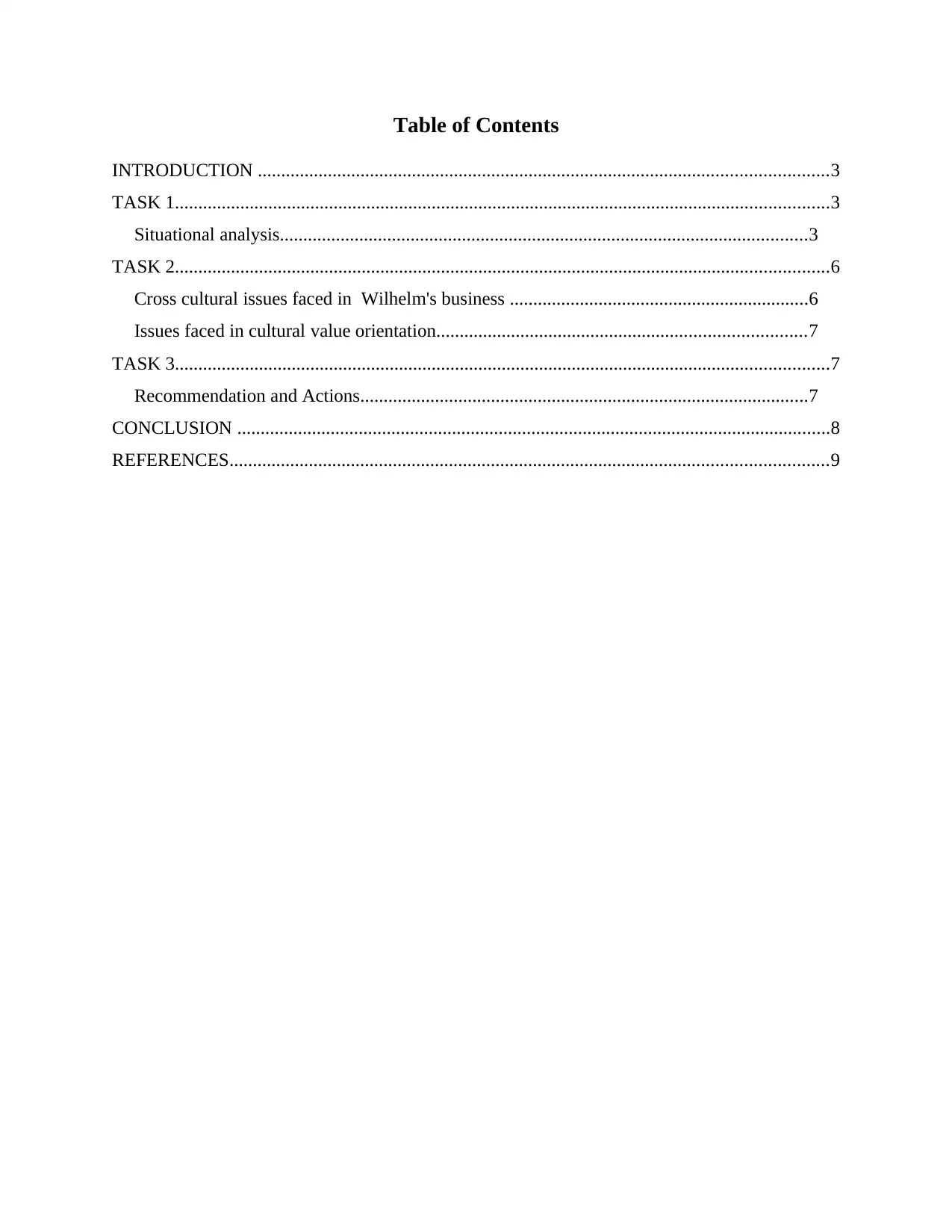
Table of Contents
INTRODUCTION ..........................................................................................................................3
TASK 1............................................................................................................................................3
Situational analysis.................................................................................................................3
TASK 2............................................................................................................................................6
Cross cultural issues faced in Wilhelm's business ................................................................6
Issues faced in cultural value orientation...............................................................................7
TASK 3............................................................................................................................................7
Recommendation and Actions................................................................................................7
CONCLUSION ...............................................................................................................................8
REFERENCES................................................................................................................................9
INTRODUCTION ..........................................................................................................................3
TASK 1............................................................................................................................................3
Situational analysis.................................................................................................................3
TASK 2............................................................................................................................................6
Cross cultural issues faced in Wilhelm's business ................................................................6
Issues faced in cultural value orientation...............................................................................7
TASK 3............................................................................................................................................7
Recommendation and Actions................................................................................................7
CONCLUSION ...............................................................................................................................8
REFERENCES................................................................................................................................9
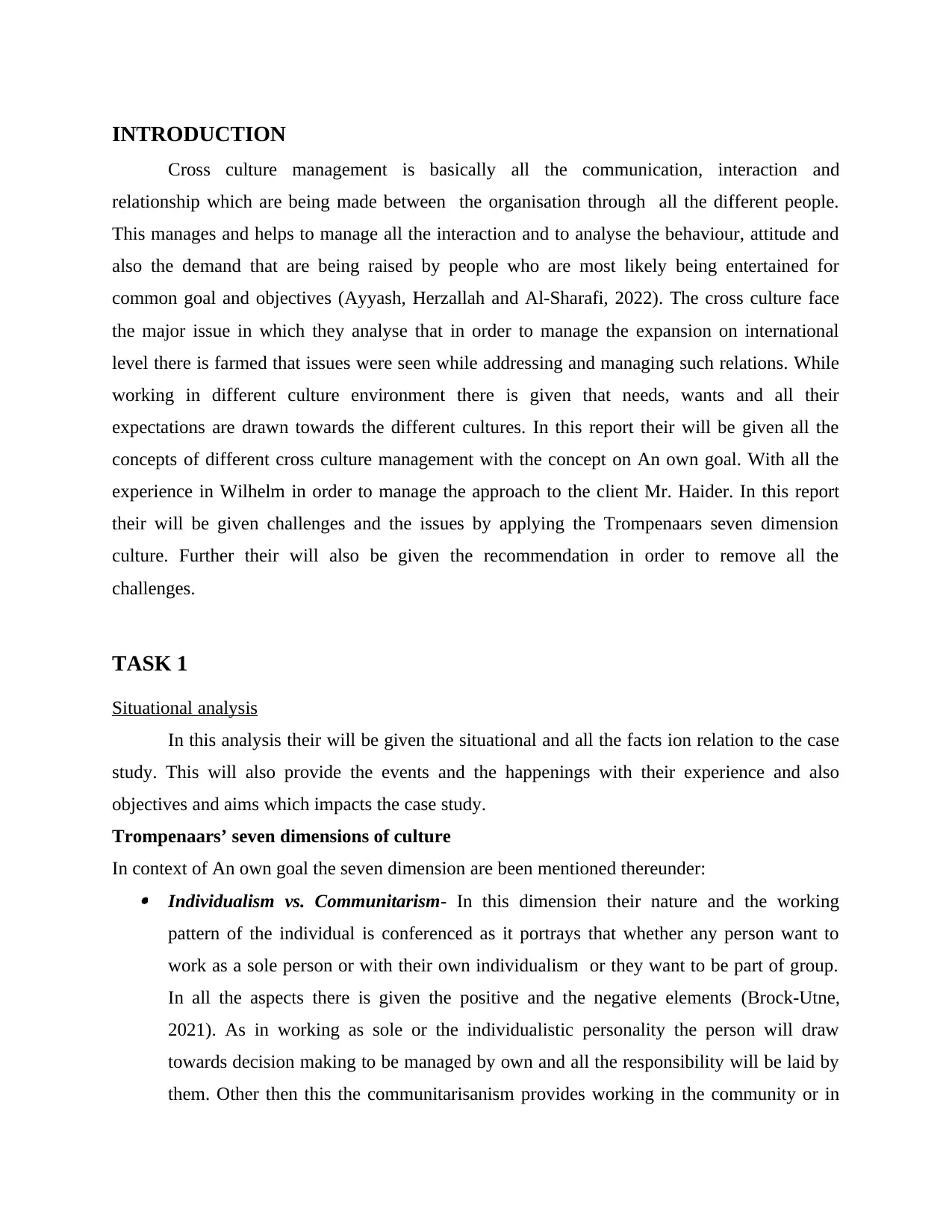
INTRODUCTION
Cross culture management is basically all the communication, interaction and
relationship which are being made between the organisation through all the different people.
This manages and helps to manage all the interaction and to analyse the behaviour, attitude and
also the demand that are being raised by people who are most likely being entertained for
common goal and objectives (Ayyash, Herzallah and Al-Sharafi, 2022). The cross culture face
the major issue in which they analyse that in order to manage the expansion on international
level there is farmed that issues were seen while addressing and managing such relations. While
working in different culture environment there is given that needs, wants and all their
expectations are drawn towards the different cultures. In this report their will be given all the
concepts of different cross culture management with the concept on An own goal. With all the
experience in Wilhelm in order to manage the approach to the client Mr. Haider. In this report
their will be given challenges and the issues by applying the Trompenaars seven dimension
culture. Further their will also be given the recommendation in order to remove all the
challenges.
TASK 1
Situational analysis
In this analysis their will be given the situational and all the facts ion relation to the case
study. This will also provide the events and the happenings with their experience and also
objectives and aims which impacts the case study.
Trompenaars’ seven dimensions of culture
In context of An own goal the seven dimension are been mentioned thereunder: Individualism vs. Communitarism- In this dimension their nature and the working
pattern of the individual is conferenced as it portrays that whether any person want to
work as a sole person or with their own individualism or they want to be part of group.
In all the aspects there is given the positive and the negative elements (Brock-Utne,
2021). As in working as sole or the individualistic personality the person will draw
towards decision making to be managed by own and all the responsibility will be laid by
them. Other then this the communitarisanism provides working in the community or in
Cross culture management is basically all the communication, interaction and
relationship which are being made between the organisation through all the different people.
This manages and helps to manage all the interaction and to analyse the behaviour, attitude and
also the demand that are being raised by people who are most likely being entertained for
common goal and objectives (Ayyash, Herzallah and Al-Sharafi, 2022). The cross culture face
the major issue in which they analyse that in order to manage the expansion on international
level there is farmed that issues were seen while addressing and managing such relations. While
working in different culture environment there is given that needs, wants and all their
expectations are drawn towards the different cultures. In this report their will be given all the
concepts of different cross culture management with the concept on An own goal. With all the
experience in Wilhelm in order to manage the approach to the client Mr. Haider. In this report
their will be given challenges and the issues by applying the Trompenaars seven dimension
culture. Further their will also be given the recommendation in order to remove all the
challenges.
TASK 1
Situational analysis
In this analysis their will be given the situational and all the facts ion relation to the case
study. This will also provide the events and the happenings with their experience and also
objectives and aims which impacts the case study.
Trompenaars’ seven dimensions of culture
In context of An own goal the seven dimension are been mentioned thereunder: Individualism vs. Communitarism- In this dimension their nature and the working
pattern of the individual is conferenced as it portrays that whether any person want to
work as a sole person or with their own individualism or they want to be part of group.
In all the aspects there is given the positive and the negative elements (Brock-Utne,
2021). As in working as sole or the individualistic personality the person will draw
towards decision making to be managed by own and all the responsibility will be laid by
them. Other then this the communitarisanism provides working in the community or in
⊘ This is a preview!⊘
Do you want full access?
Subscribe today to unlock all pages.

Trusted by 1+ million students worldwide
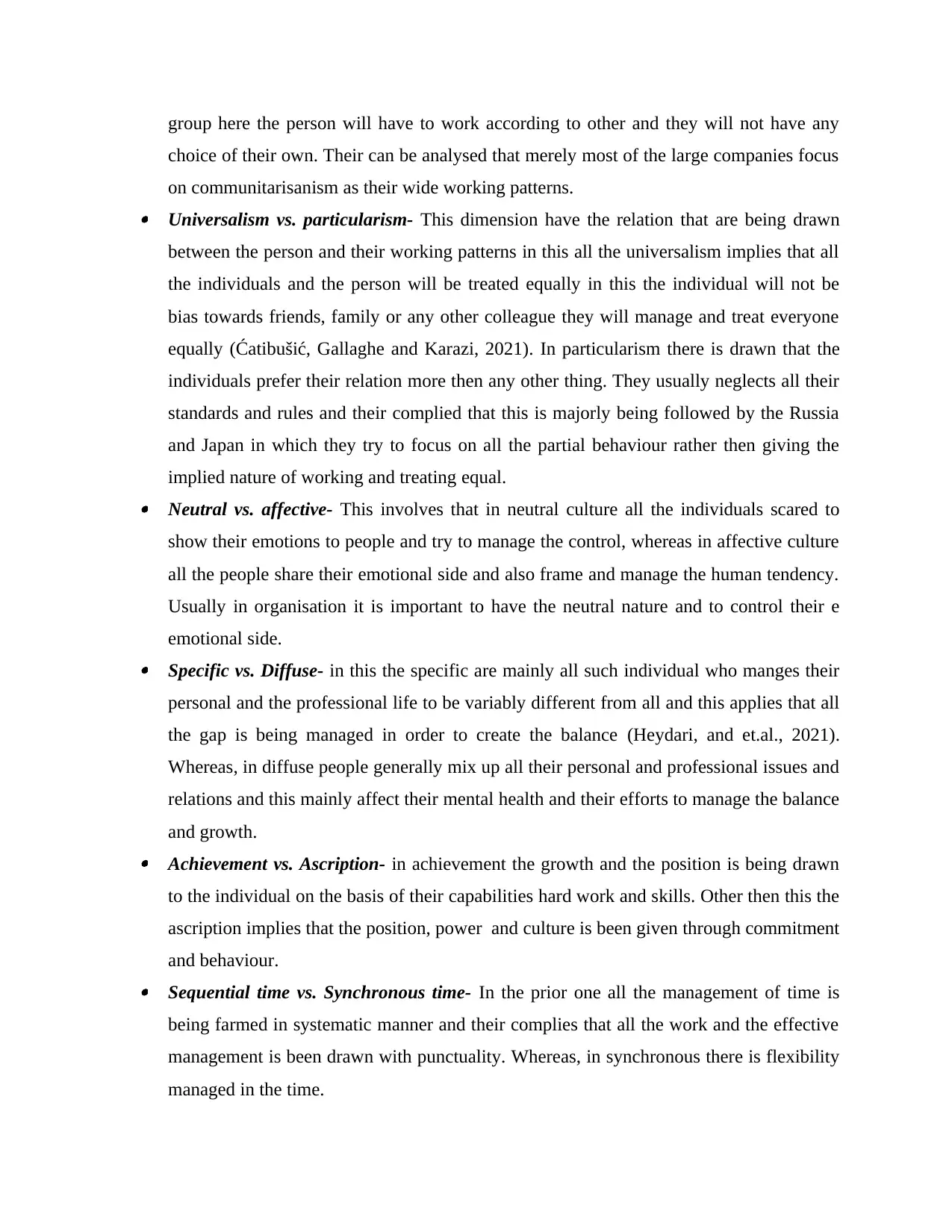
group here the person will have to work according to other and they will not have any
choice of their own. Their can be analysed that merely most of the large companies focus
on communitarisanism as their wide working patterns. Universalism vs. particularism- This dimension have the relation that are being drawn
between the person and their working patterns in this all the universalism implies that all
the individuals and the person will be treated equally in this the individual will not be
bias towards friends, family or any other colleague they will manage and treat everyone
equally (Ćatibušić, Gallaghe and Karazi, 2021). In particularism there is drawn that the
individuals prefer their relation more then any other thing. They usually neglects all their
standards and rules and their complied that this is majorly being followed by the Russia
and Japan in which they try to focus on all the partial behaviour rather then giving the
implied nature of working and treating equal. Neutral vs. affective- This involves that in neutral culture all the individuals scared to
show their emotions to people and try to manage the control, whereas in affective culture
all the people share their emotional side and also frame and manage the human tendency.
Usually in organisation it is important to have the neutral nature and to control their e
emotional side. Specific vs. Diffuse- in this the specific are mainly all such individual who manges their
personal and the professional life to be variably different from all and this applies that all
the gap is being managed in order to create the balance (Heydari, and et.al., 2021).
Whereas, in diffuse people generally mix up all their personal and professional issues and
relations and this mainly affect their mental health and their efforts to manage the balance
and growth. Achievement vs. Ascription- in achievement the growth and the position is being drawn
to the individual on the basis of their capabilities hard work and skills. Other then this the
ascription implies that the position, power and culture is been given through commitment
and behaviour. Sequential time vs. Synchronous time- In the prior one all the management of time is
being farmed in systematic manner and their complies that all the work and the effective
management is been drawn with punctuality. Whereas, in synchronous there is flexibility
managed in the time.
choice of their own. Their can be analysed that merely most of the large companies focus
on communitarisanism as their wide working patterns. Universalism vs. particularism- This dimension have the relation that are being drawn
between the person and their working patterns in this all the universalism implies that all
the individuals and the person will be treated equally in this the individual will not be
bias towards friends, family or any other colleague they will manage and treat everyone
equally (Ćatibušić, Gallaghe and Karazi, 2021). In particularism there is drawn that the
individuals prefer their relation more then any other thing. They usually neglects all their
standards and rules and their complied that this is majorly being followed by the Russia
and Japan in which they try to focus on all the partial behaviour rather then giving the
implied nature of working and treating equal. Neutral vs. affective- This involves that in neutral culture all the individuals scared to
show their emotions to people and try to manage the control, whereas in affective culture
all the people share their emotional side and also frame and manage the human tendency.
Usually in organisation it is important to have the neutral nature and to control their e
emotional side. Specific vs. Diffuse- in this the specific are mainly all such individual who manges their
personal and the professional life to be variably different from all and this applies that all
the gap is being managed in order to create the balance (Heydari, and et.al., 2021).
Whereas, in diffuse people generally mix up all their personal and professional issues and
relations and this mainly affect their mental health and their efforts to manage the balance
and growth. Achievement vs. Ascription- in achievement the growth and the position is being drawn
to the individual on the basis of their capabilities hard work and skills. Other then this the
ascription implies that the position, power and culture is been given through commitment
and behaviour. Sequential time vs. Synchronous time- In the prior one all the management of time is
being farmed in systematic manner and their complies that all the work and the effective
management is been drawn with punctuality. Whereas, in synchronous there is flexibility
managed in the time.
Paraphrase This Document
Need a fresh take? Get an instant paraphrase of this document with our AI Paraphraser
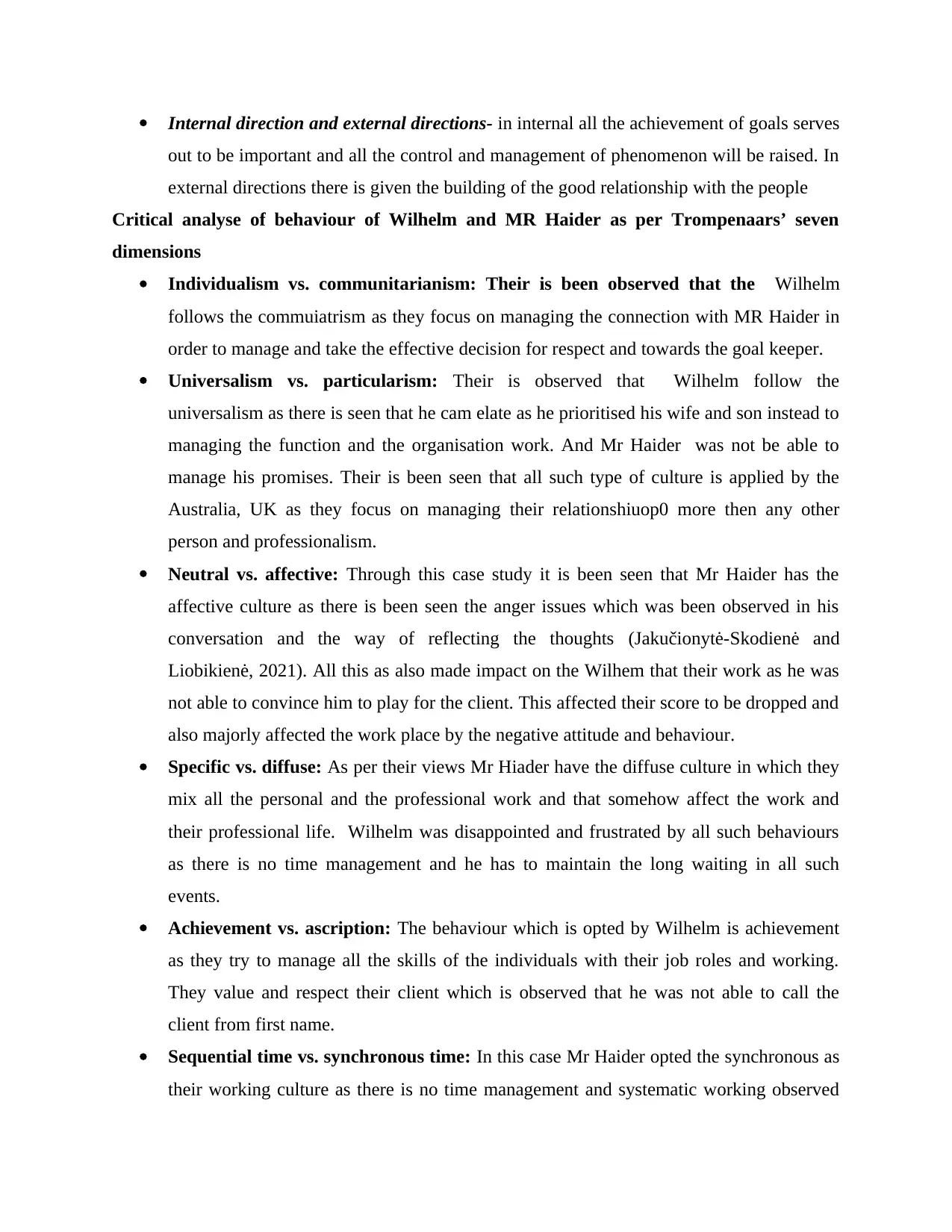
Internal direction and external directions- in internal all the achievement of goals serves
out to be important and all the control and management of phenomenon will be raised. In
external directions there is given the building of the good relationship with the people
Critical analyse of behaviour of Wilhelm and MR Haider as per Trompenaars’ seven
dimensions
Individualism vs. communitarianism: Their is been observed that the Wilhelm
follows the commuiatrism as they focus on managing the connection with MR Haider in
order to manage and take the effective decision for respect and towards the goal keeper.
Universalism vs. particularism: Their is observed that Wilhelm follow the
universalism as there is seen that he cam elate as he prioritised his wife and son instead to
managing the function and the organisation work. And Mr Haider was not be able to
manage his promises. Their is been seen that all such type of culture is applied by the
Australia, UK as they focus on managing their relationshiuop0 more then any other
person and professionalism.
Neutral vs. affective: Through this case study it is been seen that Mr Haider has the
affective culture as there is been seen the anger issues which was been observed in his
conversation and the way of reflecting the thoughts (Jakučionytė-Skodienė and
Liobikienė, 2021). All this as also made impact on the Wilhem that their work as he was
not able to convince him to play for the client. This affected their score to be dropped and
also majorly affected the work place by the negative attitude and behaviour.
Specific vs. diffuse: As per their views Mr Hiader have the diffuse culture in which they
mix all the personal and the professional work and that somehow affect the work and
their professional life. Wilhelm was disappointed and frustrated by all such behaviours
as there is no time management and he has to maintain the long waiting in all such
events.
Achievement vs. ascription: The behaviour which is opted by Wilhelm is achievement
as they try to manage all the skills of the individuals with their job roles and working.
They value and respect their client which is observed that he was not able to call the
client from first name.
Sequential time vs. synchronous time: In this case Mr Haider opted the synchronous as
their working culture as there is no time management and systematic working observed
out to be important and all the control and management of phenomenon will be raised. In
external directions there is given the building of the good relationship with the people
Critical analyse of behaviour of Wilhelm and MR Haider as per Trompenaars’ seven
dimensions
Individualism vs. communitarianism: Their is been observed that the Wilhelm
follows the commuiatrism as they focus on managing the connection with MR Haider in
order to manage and take the effective decision for respect and towards the goal keeper.
Universalism vs. particularism: Their is observed that Wilhelm follow the
universalism as there is seen that he cam elate as he prioritised his wife and son instead to
managing the function and the organisation work. And Mr Haider was not be able to
manage his promises. Their is been seen that all such type of culture is applied by the
Australia, UK as they focus on managing their relationshiuop0 more then any other
person and professionalism.
Neutral vs. affective: Through this case study it is been seen that Mr Haider has the
affective culture as there is been seen the anger issues which was been observed in his
conversation and the way of reflecting the thoughts (Jakučionytė-Skodienė and
Liobikienė, 2021). All this as also made impact on the Wilhem that their work as he was
not able to convince him to play for the client. This affected their score to be dropped and
also majorly affected the work place by the negative attitude and behaviour.
Specific vs. diffuse: As per their views Mr Hiader have the diffuse culture in which they
mix all the personal and the professional work and that somehow affect the work and
their professional life. Wilhelm was disappointed and frustrated by all such behaviours
as there is no time management and he has to maintain the long waiting in all such
events.
Achievement vs. ascription: The behaviour which is opted by Wilhelm is achievement
as they try to manage all the skills of the individuals with their job roles and working.
They value and respect their client which is observed that he was not able to call the
client from first name.
Sequential time vs. synchronous time: In this case Mr Haider opted the synchronous as
their working culture as there is no time management and systematic working observed
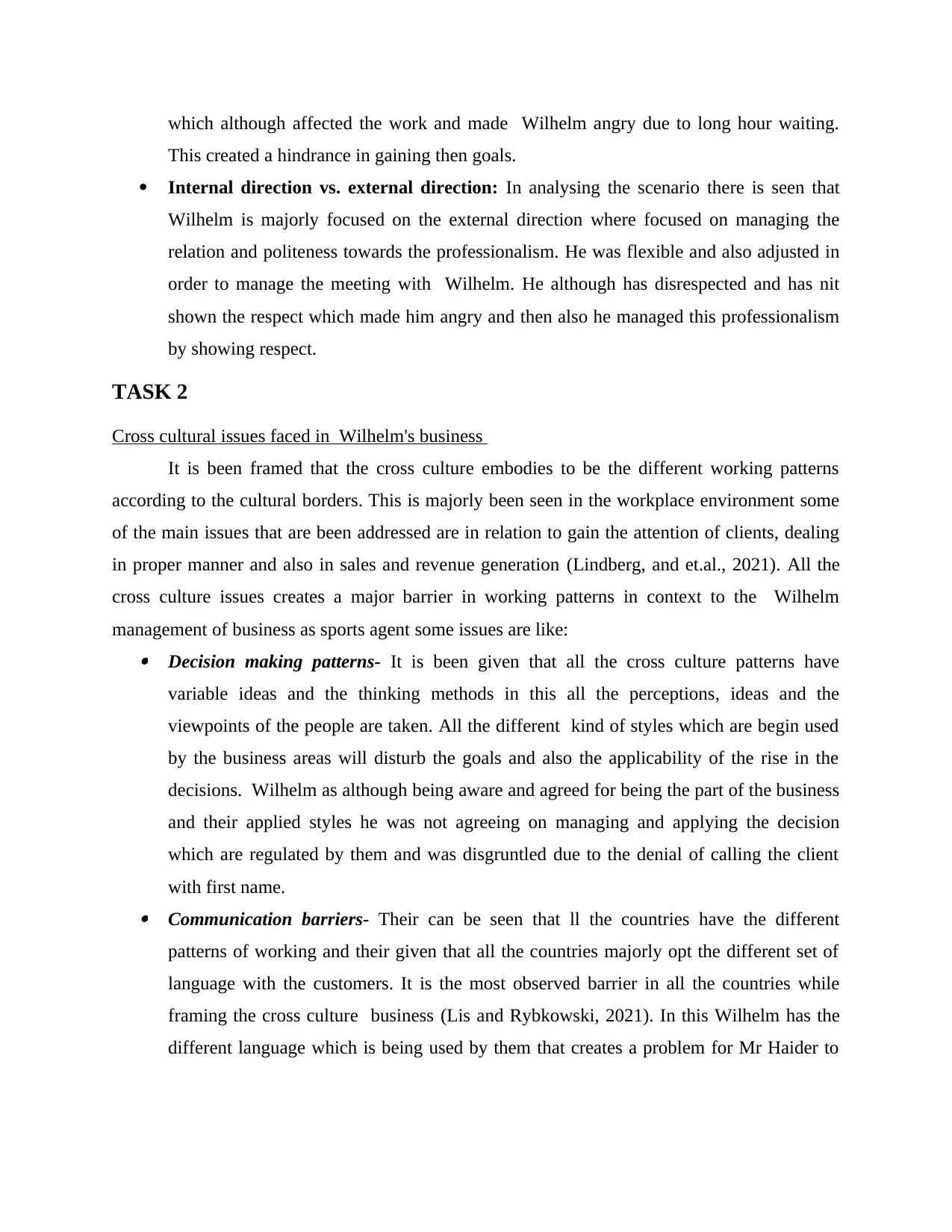
which although affected the work and made Wilhelm angry due to long hour waiting.
This created a hindrance in gaining then goals.
Internal direction vs. external direction: In analysing the scenario there is seen that
Wilhelm is majorly focused on the external direction where focused on managing the
relation and politeness towards the professionalism. He was flexible and also adjusted in
order to manage the meeting with Wilhelm. He although has disrespected and has nit
shown the respect which made him angry and then also he managed this professionalism
by showing respect.
TASK 2
Cross cultural issues faced in Wilhelm's business
It is been framed that the cross culture embodies to be the different working patterns
according to the cultural borders. This is majorly been seen in the workplace environment some
of the main issues that are been addressed are in relation to gain the attention of clients, dealing
in proper manner and also in sales and revenue generation (Lindberg, and et.al., 2021). All the
cross culture issues creates a major barrier in working patterns in context to the Wilhelm
management of business as sports agent some issues are like: Decision making patterns- It is been given that all the cross culture patterns have
variable ideas and the thinking methods in this all the perceptions, ideas and the
viewpoints of the people are taken. All the different kind of styles which are begin used
by the business areas will disturb the goals and also the applicability of the rise in the
decisions. Wilhelm as although being aware and agreed for being the part of the business
and their applied styles he was not agreeing on managing and applying the decision
which are regulated by them and was disgruntled due to the denial of calling the client
with first name. Communication barriers- Their can be seen that ll the countries have the different
patterns of working and their given that all the countries majorly opt the different set of
language with the customers. It is the most observed barrier in all the countries while
framing the cross culture business (Lis and Rybkowski, 2021). In this Wilhelm has the
different language which is being used by them that creates a problem for Mr Haider to
This created a hindrance in gaining then goals.
Internal direction vs. external direction: In analysing the scenario there is seen that
Wilhelm is majorly focused on the external direction where focused on managing the
relation and politeness towards the professionalism. He was flexible and also adjusted in
order to manage the meeting with Wilhelm. He although has disrespected and has nit
shown the respect which made him angry and then also he managed this professionalism
by showing respect.
TASK 2
Cross cultural issues faced in Wilhelm's business
It is been framed that the cross culture embodies to be the different working patterns
according to the cultural borders. This is majorly been seen in the workplace environment some
of the main issues that are been addressed are in relation to gain the attention of clients, dealing
in proper manner and also in sales and revenue generation (Lindberg, and et.al., 2021). All the
cross culture issues creates a major barrier in working patterns in context to the Wilhelm
management of business as sports agent some issues are like: Decision making patterns- It is been given that all the cross culture patterns have
variable ideas and the thinking methods in this all the perceptions, ideas and the
viewpoints of the people are taken. All the different kind of styles which are begin used
by the business areas will disturb the goals and also the applicability of the rise in the
decisions. Wilhelm as although being aware and agreed for being the part of the business
and their applied styles he was not agreeing on managing and applying the decision
which are regulated by them and was disgruntled due to the denial of calling the client
with first name. Communication barriers- Their can be seen that ll the countries have the different
patterns of working and their given that all the countries majorly opt the different set of
language with the customers. It is the most observed barrier in all the countries while
framing the cross culture business (Lis and Rybkowski, 2021). In this Wilhelm has the
different language which is being used by them that creates a problem for Mr Haider to
⊘ This is a preview!⊘
Do you want full access?
Subscribe today to unlock all pages.

Trusted by 1+ million students worldwide
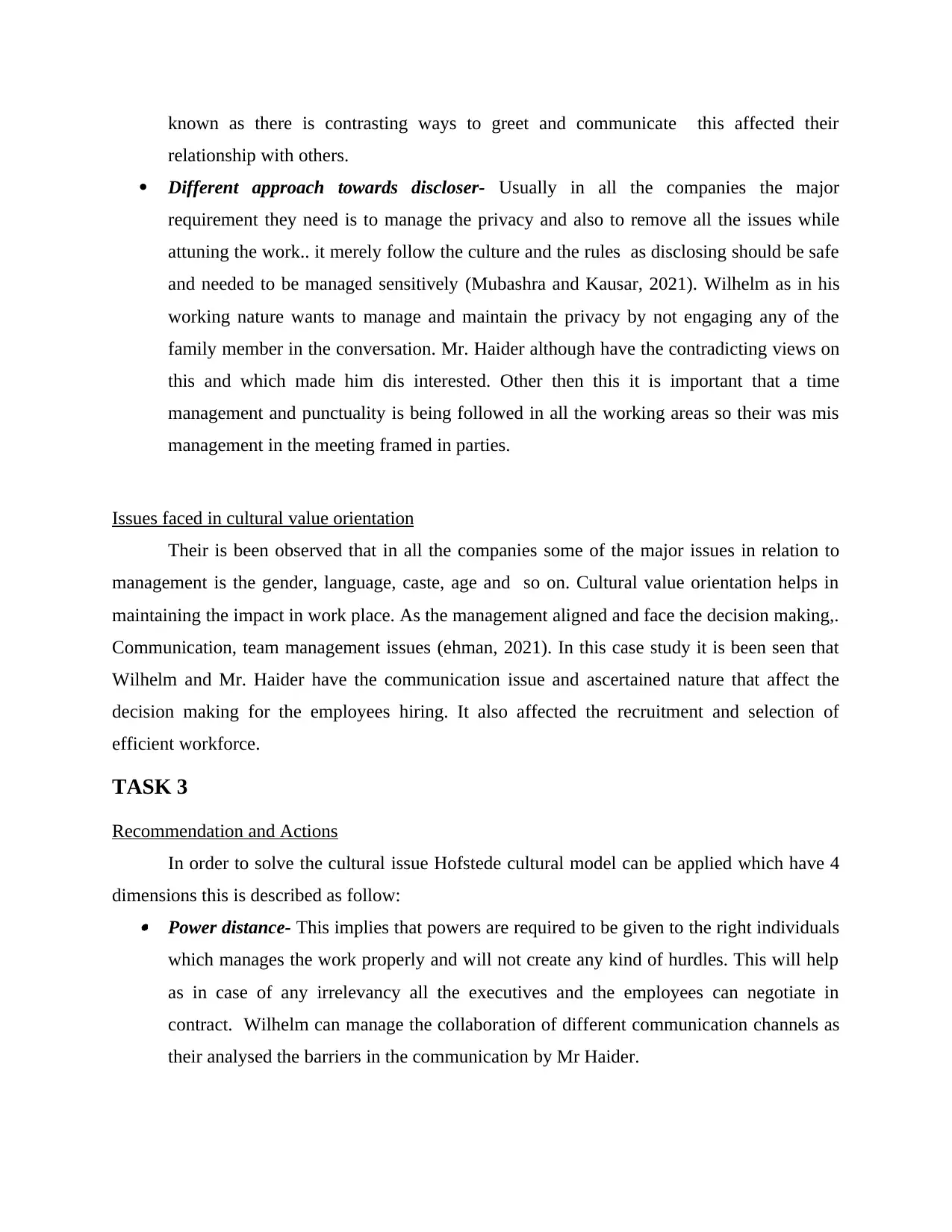
known as there is contrasting ways to greet and communicate this affected their
relationship with others.
Different approach towards discloser- Usually in all the companies the major
requirement they need is to manage the privacy and also to remove all the issues while
attuning the work.. it merely follow the culture and the rules as disclosing should be safe
and needed to be managed sensitively (Mubashra and Kausar, 2021). Wilhelm as in his
working nature wants to manage and maintain the privacy by not engaging any of the
family member in the conversation. Mr. Haider although have the contradicting views on
this and which made him dis interested. Other then this it is important that a time
management and punctuality is being followed in all the working areas so their was mis
management in the meeting framed in parties.
Issues faced in cultural value orientation
Their is been observed that in all the companies some of the major issues in relation to
management is the gender, language, caste, age and so on. Cultural value orientation helps in
maintaining the impact in work place. As the management aligned and face the decision making,.
Communication, team management issues (ehman, 2021). In this case study it is been seen that
Wilhelm and Mr. Haider have the communication issue and ascertained nature that affect the
decision making for the employees hiring. It also affected the recruitment and selection of
efficient workforce.
TASK 3
Recommendation and Actions
In order to solve the cultural issue Hofstede cultural model can be applied which have 4
dimensions this is described as follow: Power distance- This implies that powers are required to be given to the right individuals
which manages the work properly and will not create any kind of hurdles. This will help
as in case of any irrelevancy all the executives and the employees can negotiate in
contract. Wilhelm can manage the collaboration of different communication channels as
their analysed the barriers in the communication by Mr Haider.
relationship with others.
Different approach towards discloser- Usually in all the companies the major
requirement they need is to manage the privacy and also to remove all the issues while
attuning the work.. it merely follow the culture and the rules as disclosing should be safe
and needed to be managed sensitively (Mubashra and Kausar, 2021). Wilhelm as in his
working nature wants to manage and maintain the privacy by not engaging any of the
family member in the conversation. Mr. Haider although have the contradicting views on
this and which made him dis interested. Other then this it is important that a time
management and punctuality is being followed in all the working areas so their was mis
management in the meeting framed in parties.
Issues faced in cultural value orientation
Their is been observed that in all the companies some of the major issues in relation to
management is the gender, language, caste, age and so on. Cultural value orientation helps in
maintaining the impact in work place. As the management aligned and face the decision making,.
Communication, team management issues (ehman, 2021). In this case study it is been seen that
Wilhelm and Mr. Haider have the communication issue and ascertained nature that affect the
decision making for the employees hiring. It also affected the recruitment and selection of
efficient workforce.
TASK 3
Recommendation and Actions
In order to solve the cultural issue Hofstede cultural model can be applied which have 4
dimensions this is described as follow: Power distance- This implies that powers are required to be given to the right individuals
which manages the work properly and will not create any kind of hurdles. This will help
as in case of any irrelevancy all the executives and the employees can negotiate in
contract. Wilhelm can manage the collaboration of different communication channels as
their analysed the barriers in the communication by Mr Haider.
Paraphrase This Document
Need a fresh take? Get an instant paraphrase of this document with our AI Paraphraser
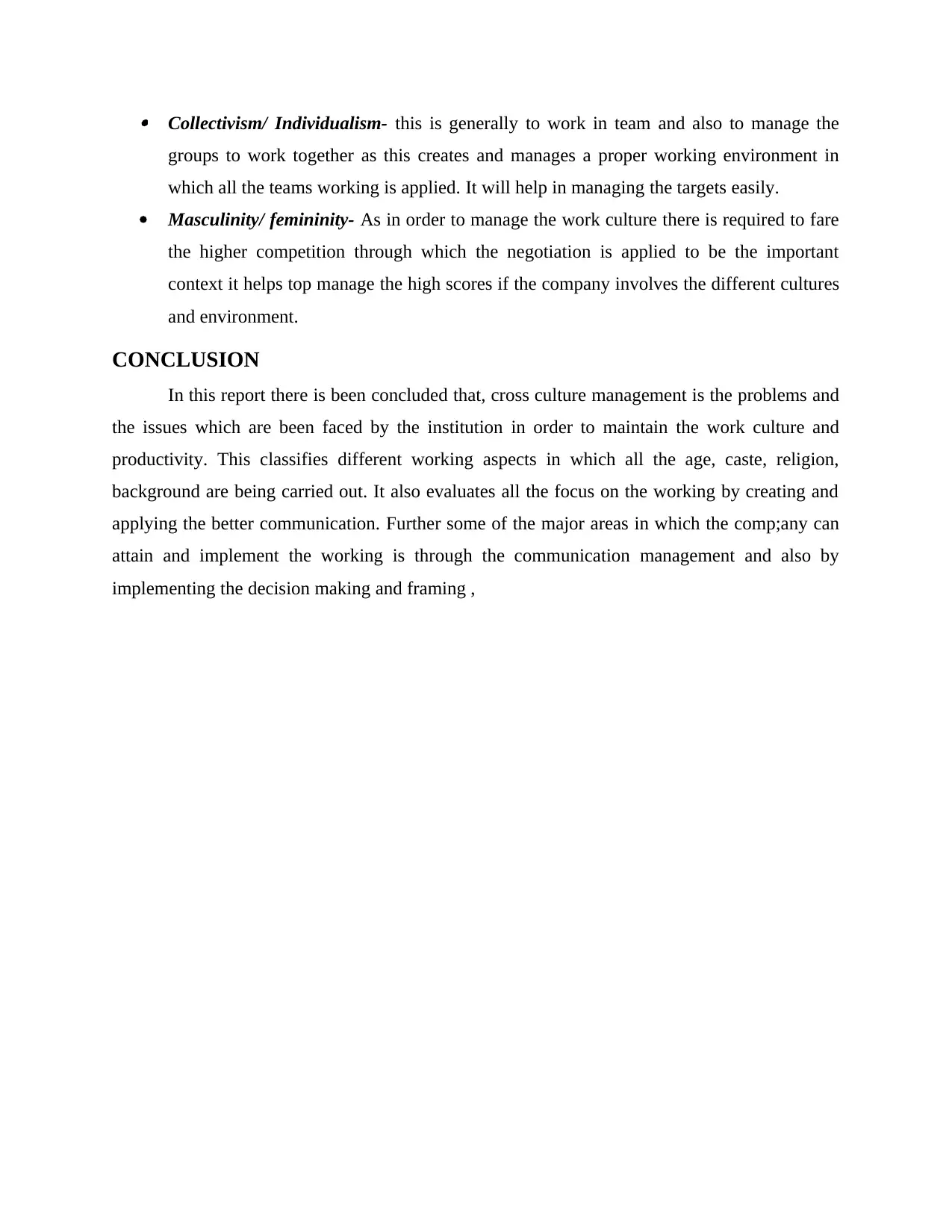
Collectivism/ Individualism- this is generally to work in team and also to manage the
groups to work together as this creates and manages a proper working environment in
which all the teams working is applied. It will help in managing the targets easily.
Masculinity/ femininity- As in order to manage the work culture there is required to fare
the higher competition through which the negotiation is applied to be the important
context it helps top manage the high scores if the company involves the different cultures
and environment.
CONCLUSION
In this report there is been concluded that, cross culture management is the problems and
the issues which are been faced by the institution in order to maintain the work culture and
productivity. This classifies different working aspects in which all the age, caste, religion,
background are being carried out. It also evaluates all the focus on the working by creating and
applying the better communication. Further some of the major areas in which the comp;any can
attain and implement the working is through the communication management and also by
implementing the decision making and framing ,
groups to work together as this creates and manages a proper working environment in
which all the teams working is applied. It will help in managing the targets easily.
Masculinity/ femininity- As in order to manage the work culture there is required to fare
the higher competition through which the negotiation is applied to be the important
context it helps top manage the high scores if the company involves the different cultures
and environment.
CONCLUSION
In this report there is been concluded that, cross culture management is the problems and
the issues which are been faced by the institution in order to maintain the work culture and
productivity. This classifies different working aspects in which all the age, caste, religion,
background are being carried out. It also evaluates all the focus on the working by creating and
applying the better communication. Further some of the major areas in which the comp;any can
attain and implement the working is through the communication management and also by
implementing the decision making and framing ,
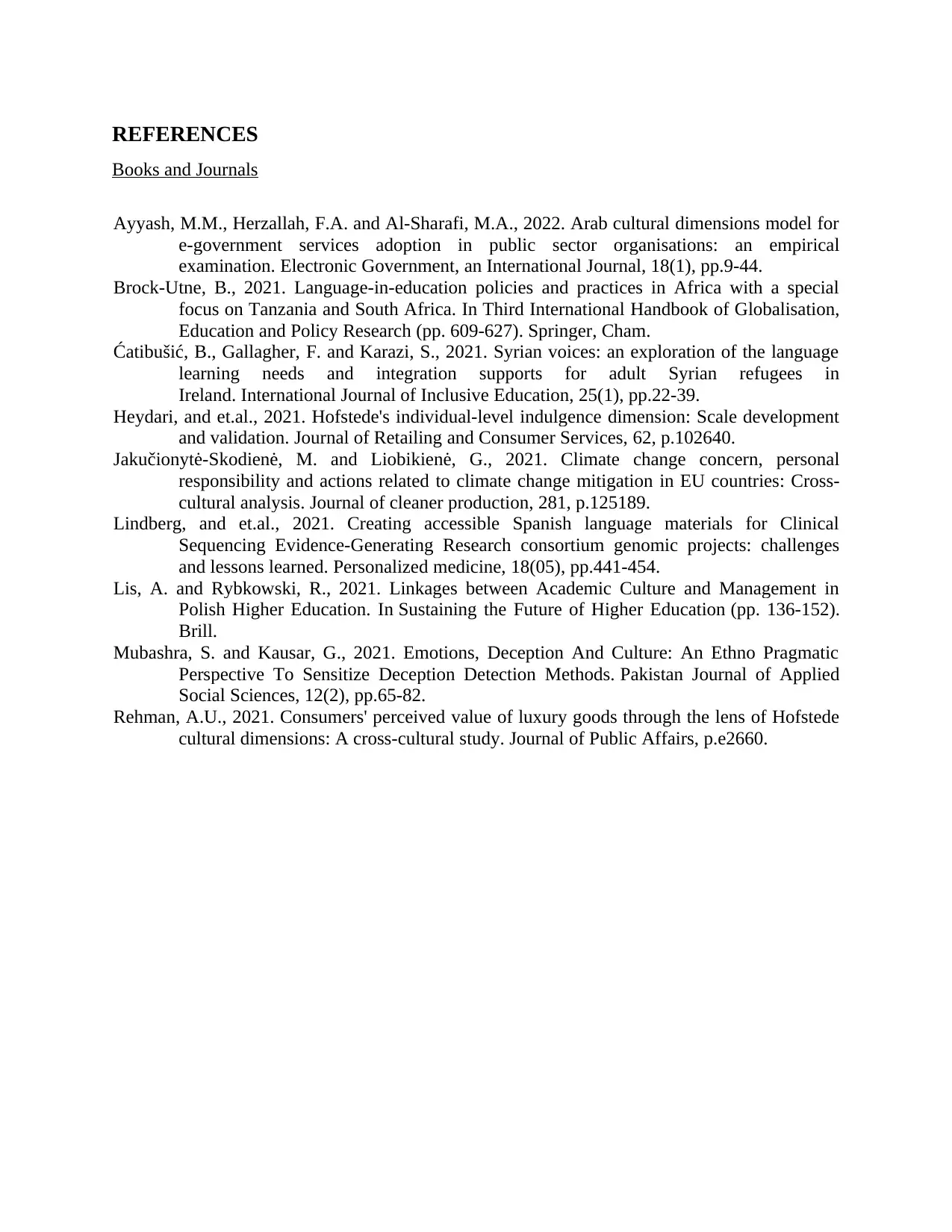
REFERENCES
Books and Journals
Ayyash, M.M., Herzallah, F.A. and Al-Sharafi, M.A., 2022. Arab cultural dimensions model for
e-government services adoption in public sector organisations: an empirical
examination. Electronic Government, an International Journal, 18(1), pp.9-44.
Brock-Utne, B., 2021. Language-in-education policies and practices in Africa with a special
focus on Tanzania and South Africa. In Third International Handbook of Globalisation,
Education and Policy Research (pp. 609-627). Springer, Cham.
Ćatibušić, B., Gallagher, F. and Karazi, S., 2021. Syrian voices: an exploration of the language
learning needs and integration supports for adult Syrian refugees in
Ireland. International Journal of Inclusive Education, 25(1), pp.22-39.
Heydari, and et.al., 2021. Hofstede's individual-level indulgence dimension: Scale development
and validation. Journal of Retailing and Consumer Services, 62, p.102640.
Jakučionytė-Skodienė, M. and Liobikienė, G., 2021. Climate change concern, personal
responsibility and actions related to climate change mitigation in EU countries: Cross-
cultural analysis. Journal of cleaner production, 281, p.125189.
Lindberg, and et.al., 2021. Creating accessible Spanish language materials for Clinical
Sequencing Evidence-Generating Research consortium genomic projects: challenges
and lessons learned. Personalized medicine, 18(05), pp.441-454.
Lis, A. and Rybkowski, R., 2021. Linkages between Academic Culture and Management in
Polish Higher Education. In Sustaining the Future of Higher Education (pp. 136-152).
Brill.
Mubashra, S. and Kausar, G., 2021. Emotions, Deception And Culture: An Ethno Pragmatic
Perspective To Sensitize Deception Detection Methods. Pakistan Journal of Applied
Social Sciences, 12(2), pp.65-82.
Rehman, A.U., 2021. Consumers' perceived value of luxury goods through the lens of Hofstede
cultural dimensions: A cross‐cultural study. Journal of Public Affairs, p.e2660.
Books and Journals
Ayyash, M.M., Herzallah, F.A. and Al-Sharafi, M.A., 2022. Arab cultural dimensions model for
e-government services adoption in public sector organisations: an empirical
examination. Electronic Government, an International Journal, 18(1), pp.9-44.
Brock-Utne, B., 2021. Language-in-education policies and practices in Africa with a special
focus on Tanzania and South Africa. In Third International Handbook of Globalisation,
Education and Policy Research (pp. 609-627). Springer, Cham.
Ćatibušić, B., Gallagher, F. and Karazi, S., 2021. Syrian voices: an exploration of the language
learning needs and integration supports for adult Syrian refugees in
Ireland. International Journal of Inclusive Education, 25(1), pp.22-39.
Heydari, and et.al., 2021. Hofstede's individual-level indulgence dimension: Scale development
and validation. Journal of Retailing and Consumer Services, 62, p.102640.
Jakučionytė-Skodienė, M. and Liobikienė, G., 2021. Climate change concern, personal
responsibility and actions related to climate change mitigation in EU countries: Cross-
cultural analysis. Journal of cleaner production, 281, p.125189.
Lindberg, and et.al., 2021. Creating accessible Spanish language materials for Clinical
Sequencing Evidence-Generating Research consortium genomic projects: challenges
and lessons learned. Personalized medicine, 18(05), pp.441-454.
Lis, A. and Rybkowski, R., 2021. Linkages between Academic Culture and Management in
Polish Higher Education. In Sustaining the Future of Higher Education (pp. 136-152).
Brill.
Mubashra, S. and Kausar, G., 2021. Emotions, Deception And Culture: An Ethno Pragmatic
Perspective To Sensitize Deception Detection Methods. Pakistan Journal of Applied
Social Sciences, 12(2), pp.65-82.
Rehman, A.U., 2021. Consumers' perceived value of luxury goods through the lens of Hofstede
cultural dimensions: A cross‐cultural study. Journal of Public Affairs, p.e2660.
⊘ This is a preview!⊘
Do you want full access?
Subscribe today to unlock all pages.

Trusted by 1+ million students worldwide

1 out of 10
Related Documents
Your All-in-One AI-Powered Toolkit for Academic Success.
+13062052269
info@desklib.com
Available 24*7 on WhatsApp / Email
![[object Object]](/_next/static/media/star-bottom.7253800d.svg)
Unlock your academic potential
Copyright © 2020–2025 A2Z Services. All Rights Reserved. Developed and managed by ZUCOL.




